“Well Jerry, we made it”. Those were the words spoken to me by my riding partner, Phil Behan from Ireland, on a mid-April day in 2014. It was about 2pm and we were stopped, on our bikes at the crest of a hill, having ridden at the side of a road, 4, 900 kilometres from our homes in Guangdong’s Zhongshan. That day, though, we’d only ridden from nearby Dabancheng, a mere 85 kilometres away from where we were standing. We were looking, from the top of a hill, across a dry desert style landscape at a few high-rise buildings in the distance, perhaps 12 kilometres further to our final destination;Urumqi. The air was cold, but the sun was shining. There were pools of snow or ice by the side of the road, but the road was very clear.
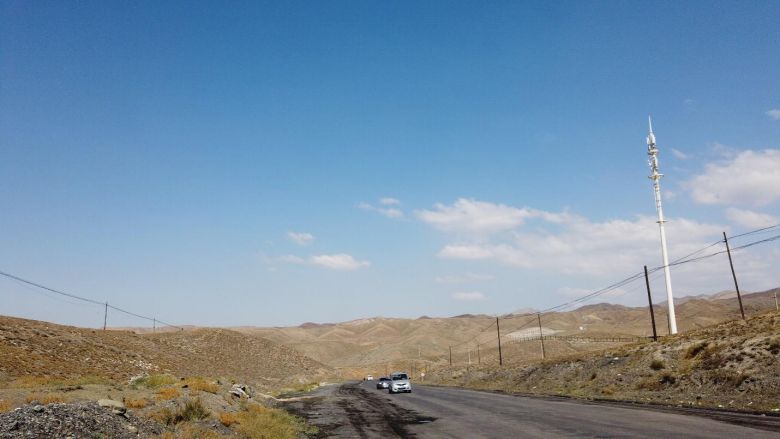
The dry hills outside of Urumqi.We had left the border of Macau on 28th February and, about 6 weeks later, passed across the border of Gansu into the Xinjiang Uyghur Autonomous Region at the beautifully named town of Xing Xing Xia, or Starry Gorge, on bicycles.
For a real sense of achievement in life you need to do something special, and, as I’d entered my fifties and felt I needed to do something to help me lose weight, see more of China, a country I’d decided to call home and, at the same time, raise some funds for charity, I’d decided riding across China would be the thing. Having left Guangdong Province in the Southeast of the country, Phil and I planned to travel to the border with Kazakhstan at the Northwest. Entering Xinjiang Autonomous Region in the East at the border town of Xing Xing Xia, you still have 785 kilometres to go to reach the capital city, it certainly felt like we were at the end of a very long road. So those five words“Well Jerry, we made it”actually brought tears to my eyes.
I had been to Urumqi before, in 2006 when I travelled there with my father. In English we usually call it Urumqi, pronounced Urumchi, in Chinese it has four characters Wu Lu Mu Qi and it’s one of the furthest cities away from an ocean in the world, so it was a strange place for me to take my father, a retired ship’s captain. He’s now 93 years old and living in the North of England, overlooking the North Sea. He still talks about the time his son took him as far away from an ocean as he’s ever been.
In 2006, Urumqi was definitely not like it is today. It was the first time in my life I’d seen a camel outside of a zoo. They were there for the tourists. That trip with my father was also a long one. We had travelled on the older style slower green trains, because there were no high-speed trains in China at the time. But if I had been given the choice, I think I would still have picked the slower green train for the experience which both my father, who was 76 at the time, and I enjoyed very much. The last few hours on the train were spent looking out of the window at huge expanses of desert. We knew we were in the desert, there was no doubt about that, the air was dry, dusty and hot, there were a few small villages scattered around.
At that time, there wasn’t a lot of money in Xinjiang. In rural regions, where roads were not so good, horses were used to transport goods from the markets to the stores and to help labourers carry materials along mountain tracks to get to remote towns. Xinjiang residents used either camels or donkey carts. we saw plenty of them too. Small carts pulled by a donkey and loaded with whatever the carter had been consigned to carry. It was very much a new world for people like my father and I who had both grown up and entered adulthood in the West. In England, by the time I turned 18 in 1976, my family had five cars and two motorbikes, this was because I had two older brothers who each had a car and a motorbike. For two foreigners, arriving in a region that was both remote and impoverished, seeing people still using animals to travel and transport goods is something that creates a lasting memory and caused me to realize that China, despite the wealth and development of places like Shenzhen and Shanghai, was still very much a developing country.
By 2014 though, that had changed. Donkey carts were a rarity, not quite completely gone but certainly not highly visible, and the only camels I saw were in the desert somewhere near Lop Nor, they were wild and ran away when they saw two bikers dismounting to try and get photos of them.
In 2014, lean, tanned and fit from two months of cycling across China, we were back in the city and it was remarkably different. Development had started to catch up in the West at last, the bazaar in the centre of the city had transformed from a place for local traders and tourists to mingle into a huge tourist attraction. The Minarets of the Mosque overlook the square while traders sell iced yoghurt, cold and hot tea, dates, raisons and many other dried fruits as well as musical instruments artwork and even rugs and mats for the home, or for prayer. Nothing is done quietly, there is a lot of noise, a lot of laughter and a lot of money changing hands. All part of my favourite thing about China;Poverty Alleviation.
The great thing about Poverty Alleviation is that, it isn’t charity, it isn’t just cash donations, it provides for sustainable business models that really work to alleviate poverty. The Bazaar, sometimes known as the Da Bazaar(or the Grand Bazaar in English), is full of local products. Some are mass produced but not all, in fact, probably not many. The rugs, mats, wall hangings, musical instruments all of the things you see are made locally by local people. Then, in a massive transfer of wealth, they are sold to visitors from outside the region. That’s always a good thing.
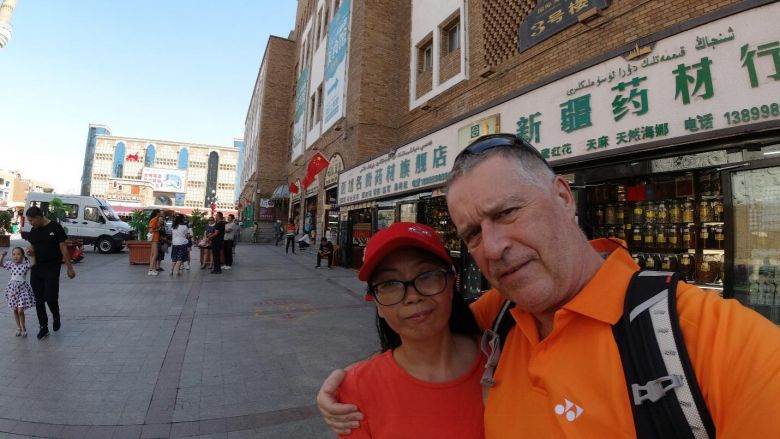
My wife and I in 2019, in the Grand Bazaar a day before setting out to ride home from Urumqi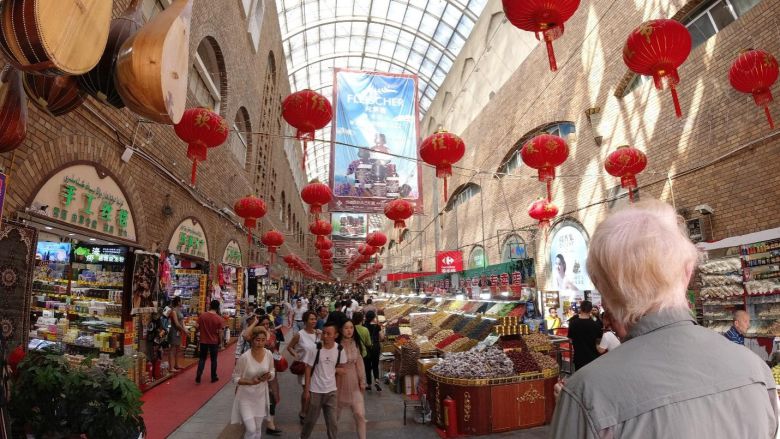
Inside the Grand Bazaar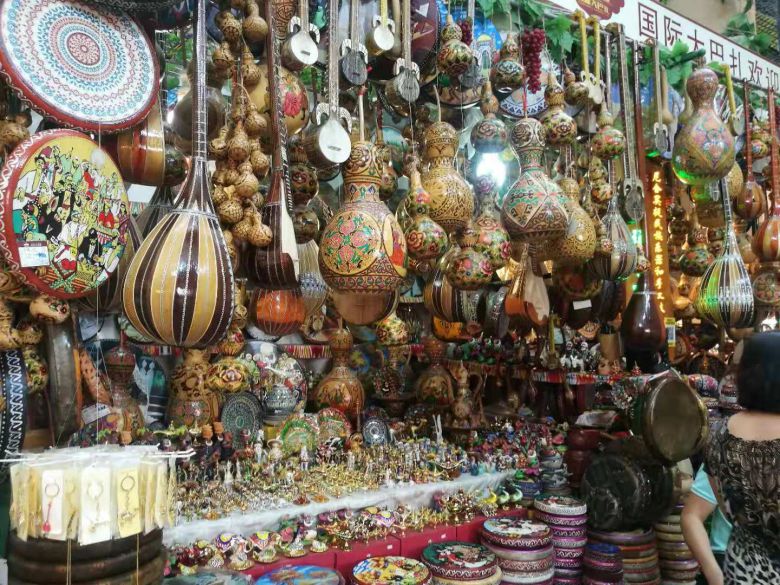
All locally made, some of them even made on the premisesAs I have a social media presence, mostly outside of China, many people ask me online which parts of China they should not miss on a trip. China is so diverse that every place is different;every place has different foods, slightly different cultures and, because of its size, every place has different weather and different environments. When people ask, which part of China should I see, I can only say“all of it”but there is something very special about Xinjiang.
You can’t get into or out of Urumqi without crossing some very arid land. Travelling towards Urumqi, from the Eastern border took us through Hami(also known as Kumul), famous for its melons. It should have been a long hot and dry ride into Turpan but for us, it wasn’t, we woke up in Hami to a cold, wet day, quite unusual for the region and the time of year, it was April. As we left the city, we climbed a long hard hill in freezing rain that turned to hailstones and then into snow. Not what we expected at all.
We camped overnight in the desert and two days later, cycled into Turpan, stopping for three nights so that we could have a good look at the city and avoid a dust storm that we were very strongly advised by our hotel owner not to attempt to travel through. In doing so, we met many great people we walked to the Emin Minaret and met a friendly group of Uyghur kids who shared their food, allowed us to take photos and became informal guides to us. Hardly the kind of thing that would have happened in a region filled with so-called oppression. Remembering that a few days before, we had left the city of Hami(Kumul)in sleet and snow, but Turpan was a very different experience. There was heat and dust. We were in the desert.
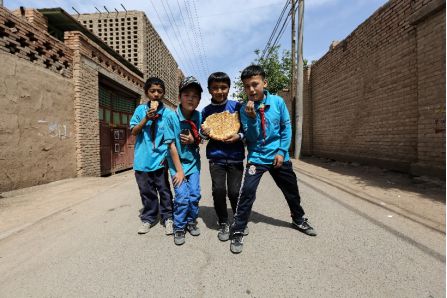
We met a friendly group of Uyghur kids who shared their foodOne of the most interesting aspects of journeys such as this is always the terrain and, Xinjiang has the most diversified terrain of all the places in China, and in fact, the rest of the world that I have seen. In the East of the Region, the Lop Nur region is sparsely populated and was, until relatively recently, almost completely isolated from the rest of China. Now, there’s a train to Lop Nur which started operation in 2012 and there had been a road built there a few years earlier. It remains to date the only place in the world where I have seen camels in the wild. It’s also home to some vital minerals and resources that China needs which might account for part of the reasons why some nations outside of China would like to see the region’s peace and stability disrupted.

I have seen camels in the wildWe’ve talked about a trip to Urumqi in 2006, another one in 2014 but my most recent trip was in 2019, and there’s more evidence of how the region has developed. This time I flew to the city with my wife. Nowadays many countries can visit China for a 144-hours visa free entry and many will say, Xinjiang is too far for such a short time and this is definitely true if travelling by train, but it’s only a five or six hour flight from anywhere on the East Coast and even less from places in the centre of China such as Wuhan or Xi’an, so it is possible.
Our first night on that journey was 20 kilometres short of Dabancheng camping in a field by a train track a couple of hundred metres off the road. I couldn’t help but wonder if the train I had been on 13 years earlier with my father had past this very field. No doubt in my mind it had.
We also went to Wen Quan. It is in Bortala Mongol Autonomous Prefecture a mountainous region that separates China’s Xinjiang from Kazakhstan’s Almaty. Despite being so close to Kazakhstan, this is a Mongolian Autonomous Region, but one where we can see Kazakhs and Mongolians living alongside each other. Languages of both countries can be seen and heard here.
We travelled to Yining, which is in Ily, a Kazakh Autonomous Prefecture and home to the most gorgeous lavender and sunflower fields, reminiscent of France’s Provence. But it’s a long way from Urumqi, with a flight time of over an hour and driving, even on the most modern highway. It is a long drive through some cotton farms.
This is a most interesting observation from a long-distance cyclist:even the most enthralling scenery can become boring when we’re travelling on bikes. We might pass a peak and see before us the magnificent Tian Shan Mountains and stare at them with awe and wonder. But two days later, when they are still in the distance, we only want to be past them and see what’s next. The same is true of the cotton fields to the West of Urumqi. Despite never in my life having seen cotton fields, and finding them fascinating, after passing only them for several hours they do become very boring. There are a lot of them, they are in abundance on the roads out of Urumqi and make a farce of Western allegations of forced labour.
To say China is diverse is accurate. It’s also as accurate to say that Xinjiang and particularly the city and surrounds of Urumqi are perhaps the most diverse regions in China. It’s not just the environment, although you can find deserts, grasslands, cotton fields, fruit production and it also has a region known as the Flaming Mountains, a desert range of mountains with such intense colours that at certain times of the day seem to be on fire, and no shortage of snow-capped mountains that make it so.
The ethnicities of the people make it an even more diverse region. The majority of the people in the region are, of course Uyghurs, then Han Chinese followed by Kazakh and Hui which contribute to the greatest diversity make up the largest amount of diversity but there are a lot more. Kirgiz and Mongols are present as are thousands of others with several different ethnicities, they bring with them their colours, their traditions and of course their food.
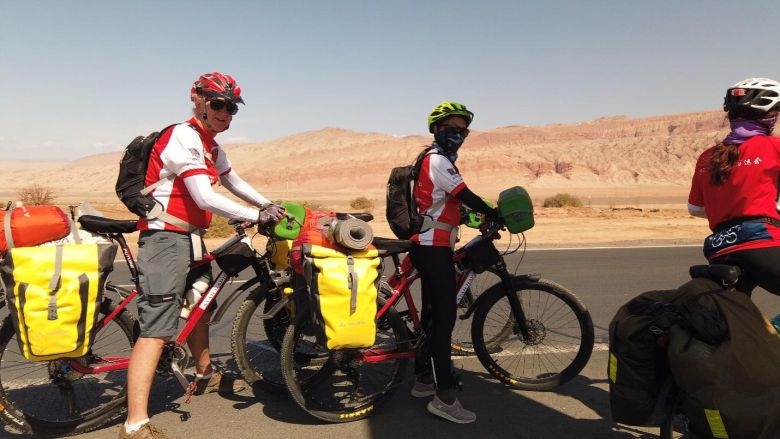
Preparing to climb the Flaming Mountains, we picked up a lone cyclist who joined us for the daySo, if there is one place no visitor to China, and no Chinese tourist should ever miss, I would have to say, this is it. Xinjiang and make sure you allow enough time to see it all, it really is as diverse as an entire continent.






